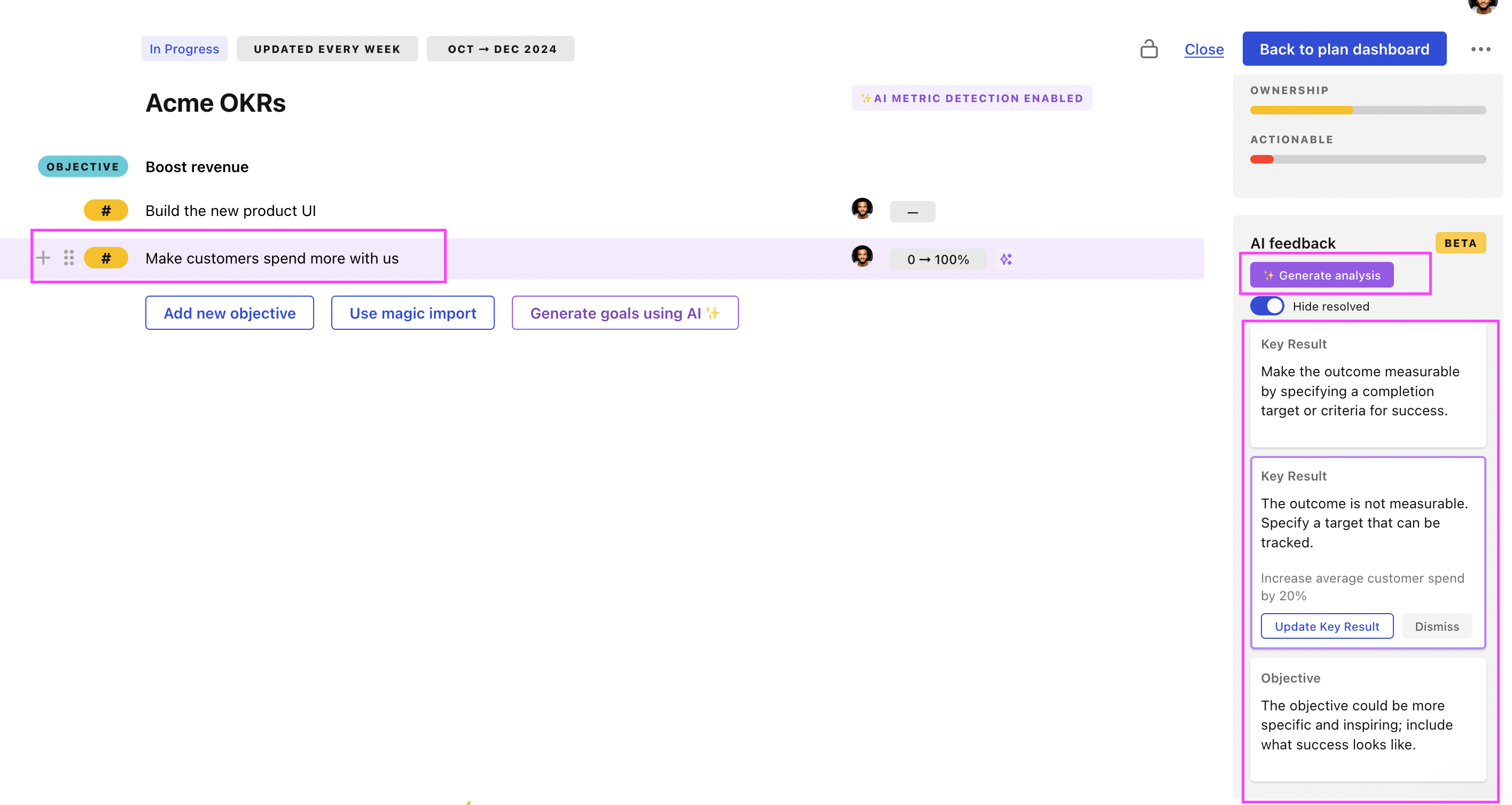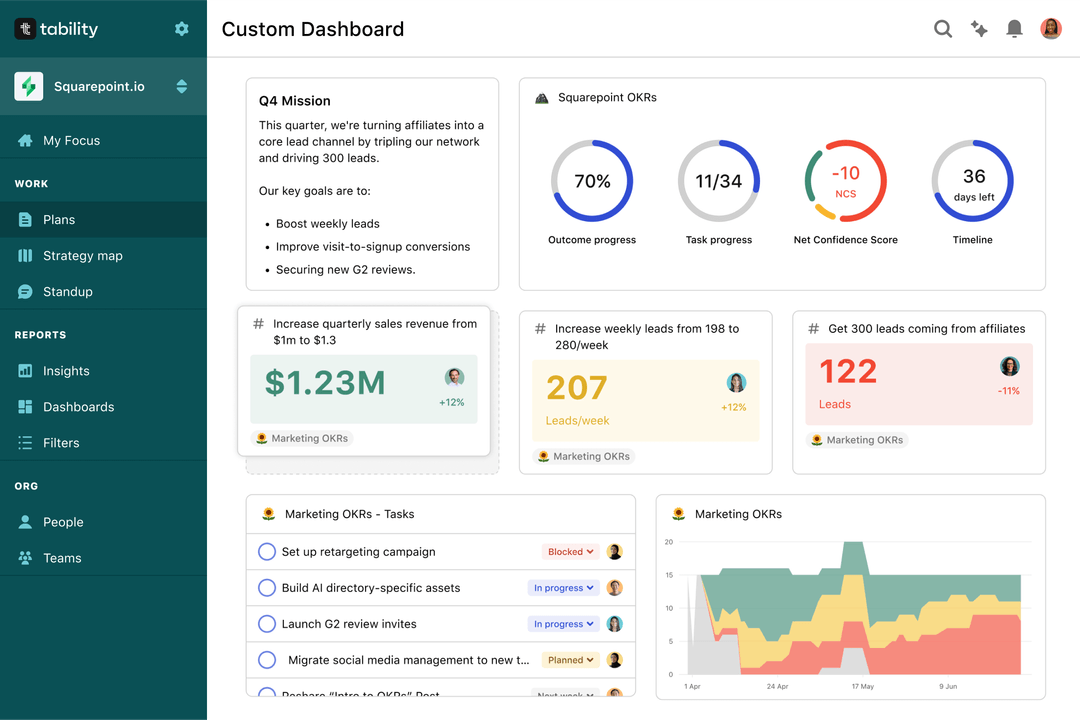Tability is a cheatcode for goal-driven teams. Set perfect OKRs with AI, stay focused on the work that matters.
What are Membership Team OKRs?
The Objective and Key Results (OKR) framework is a simple goal-setting methodology that was introduced at Intel by Andy Grove in the 70s. It became popular after John Doerr introduced it to Google in the 90s, and it's now used by teams of all sizes to set and track ambitious goals at scale.
Writing good OKRs can be hard, especially if it's your first time doing it. You'll need to center the focus of your plans around outcomes instead of projects.
We understand that setting OKRs can be challenging, so we have prepared a set of examples tailored for Membership Team. Take a peek at the templates below to find inspiration and kickstart your goal-setting process.
If you want to learn more about the framework, you can read our OKR guide online.
The best tools for writing perfect Membership Team OKRs
Here are 2 tools that can help you draft your OKRs in no time.
Tability AI: to generate OKRs based on a prompt
Tability AI allows you to describe your goals in a prompt, and generate a fully editable OKR template in seconds.
- 1. Create a Tability account
- 2. Click on the Generate goals using AI
- 3. Describe your goals in a prompt
- 4. Get your fully editable OKR template
- 5. Publish to start tracking progress and get automated OKR dashboards
Watch the video below to see it in action 👇
Tability Feedback: to improve existing OKRs
You can use Tability's AI feedback to improve your OKRs if you already have existing goals.
- 1. Create your Tability account
- 2. Add your existing OKRs (you can import them from a spreadsheet)
- 3. Click on Generate analysis
- 4. Review the suggestions and decide to accept or dismiss them
- 5. Publish to start tracking progress and get automated OKR dashboards

Tability will scan your OKRs and offer different suggestions to improve them. This can range from a small rewrite of a statement to make it clearer to a complete rewrite of the entire OKR.
Membership Team OKRs examples
You'll find below a list of Objectives and Key Results templates for Membership Team. We also included strategic projects for each template to make it easier to understand the difference between key results and projects.
Hope you'll find this helpful!
OKRs to improve our annual membership renewal rate to 90%
ObjectiveImprove our annual membership renewal rate to 90%
KRReduce membership cancellation requests by 15% through proactive member support
Develop loyalty programs and exclusive perks for members
Implement monthly member satisfaction surveys and feedback system
Train support staff in proactive customer service strategies
KRIncrease overall member satisfaction by 20% through improved services and benefits
Develop enhanced services and benefits for members
Implement strategic communication about service improvements to members
Conduct detailed survey to identify areas of member dissatisfaction
KRImplement a renewed engagement strategy, reaching out to 95% of members
Develop new engagement strategies targeting members
Analyze data to assess strategy effectiveness
Execute outreach plan to contact 95% of members
OKRs to boost our active membership count
ObjectiveBoost our active membership count
KREnhance member benefits package to improve member retention by 20%
Launch and promote the enhanced benefits package
Analyze feedback and redesign benefits package accordingly
Survey members about desired improvements in benefits package
KRImprove digital marketing strategy to grow online engagement by 30%
Research and identify popular trends in your industry for content inspiration
Engage audience with interactive content like quizzes, polls, webinars
Implement SEO practices to improve website visibility on search engines
KRImplement a referral program to generate 50 new member sign-ups
Develop a clear, attractive referral program proposal
Launch and publicize the program among current members
Train employees to promote and manage the program
OKRs to boost the growth of our member enrollment
ObjectiveBoost the growth of our member enrollment
KRImplement two new member referral programs and gain 500 enrollments
Implement and advertise the referral programs
Monitor performance and strive for 500 enrollments
Design and develop two unique member referral programs
KRAchieve a 25% rise in new weekly online member signups
Improve SEO to increase visibility on search engines
Offer unique incentives for first-time member signups
Launch a social media marketing campaign targeting potential new members
KRIncrease conversion rate from trial to full membership by 15%
Improve communication on benefits of full membership
Offer incentives for transitioning from trial to full membership
Enhance value proposition of full membership plan
OKRs to boost community membership and customer conversion
ObjectiveBoost community membership and customer conversion
KRInitiate a referral program and achieve 50% membership via referrals
Regularly analyze and adjust strategy based on referral rates
Implement a persuasive marketing campaign to promote referrals
Develop an enticing referral program centered on customer rewards
KRConvert 15% of new members into customers through targeted email marketing
Develop personalized email marketing campaigns
Track and analyze customer conversion rates
Identify member preferences for targeted emails
KRIncrease website traffic by 30% through optimized SEO techniques
Enhance site's loading speed and mobile responsiveness
Implement keyword optimization throughout the website's content
Create quality backlinks to boost page rankings
OKRs to boost Monthly Membership Subscriptions
ObjectiveBoost Monthly Membership Subscriptions
KRImplement member referral program, aiming for 15% new subscriptions
Train staff to promote and manage referral program
Develop structure and incentives for member referral program
Monitor program regularly, aiming for 15% new subscriptions
KREnhance website UX for 20% increase in membership conversion rates
Implement A/B testing for conversion optimization
Simplify signup forms and streamline onboarding
Conduct user testing to identify UX improvement areas
KRExecute 4 promotional membership campaigns to yield 25% growth
Design four different promotional membership campaigns
Adjust strategies based on campaign performances
Launch and monitor the effectiveness of these campaigns
OKRs to maximize the growth and retention of customer membership
ObjectiveMaximize the growth and retention of customer membership
KRImprove member's loyalty points redemption by 25%
Implement engaging bonus points events for active members
Introduce bonus points for frequent purchases
Enhance visibility and accessibility of redemption options
KRIncrease membership registrations by 30%
Improve the website's user-friendly registration process
Implement an aggressive social media advertising strategy
Offer referral incentives for existing members
KRReduce membership cancellations by 15%
Implement an engaging loyalty or rewards program
Regularly request and act on member feedback
Provide exceptional customer service and support
OKRs to streamline SPX single membership SDLC process
ObjectiveStreamline SPX single membership SDLC process
KRReduce the cycle time of SDLC stages by 20%
Implement automation tools in testing and deployment stages
Streamline communication channels between different teams
Adopt agile methodologies in project management
KRImplement a new tracking system to eliminate 30% of process errors
Train staff on implementing and using new system
Identify current errors and determine their root cause
Research and select appropriate tracking system
KREnhance team productivity by delivering 25% more modules within deadlines
Encourage regular communication to swiftly resolve issues
Implement efficient project management tools for better task tracking
Offer training sessions to improve team's technical skills
Membership Team OKR best practices
Generally speaking, your objectives should be ambitious yet achievable, and your key results should be measurable and time-bound (using the SMART framework can be helpful). It is also recommended to list strategic initiatives under your key results, as it'll help you avoid the common mistake of listing projects in your KRs.
Here are a couple of best practices extracted from our OKR implementation guide 👇
Tip #1: Limit the number of key results
The #1 role of OKRs is to help you and your team focus on what really matters. Business-as-usual activities will still be happening, but you do not need to track your entire roadmap in the OKRs.
We recommend having 3-4 objectives, and 3-4 key results per objective. A platform like Tability can run audits on your data to help you identify the plans that have too many goals.
Tip #2: Commit to weekly OKR check-ins
Don't fall into the set-and-forget trap. It is important to adopt a weekly check-in process to get the full value of your OKRs and make your strategy agile – otherwise this is nothing more than a reporting exercise.
Being able to see trends for your key results will also keep yourself honest.
Tip #3: No more than 2 yellow statuses in a row
Yes, this is another tip for goal-tracking instead of goal-setting (but you'll get plenty of OKR examples above). But, once you have your goals defined, it will be your ability to keep the right sense of urgency that will make the difference.
As a rule of thumb, it's best to avoid having more than 2 yellow/at risk statuses in a row.
Make a call on the 3rd update. You should be either back on track, or off track. This sounds harsh but it's the best way to signal risks early enough to fix things.
Save hours with automated Membership Team OKR dashboards

The rules of OKRs are simple. Quarterly OKRs should be tracked weekly, and yearly OKRs should be tracked monthly. Reviewing progress periodically has several advantages:
- It brings the goals back to the top of the mind
- It will highlight poorly set OKRs
- It will surface execution risks
- It improves transparency and accountability
Spreadsheets are enough to get started. Then, once you need to scale you can use Tability to save time with automated OKR dashboards, data connectors, and actionable insights.
How to get Tability dashboards:
- 1. Create a Tability account
- 2. Use the importers to add your OKRs (works with any spreadsheet or doc)
- 3. Publish your OKR plan
That's it! Tability will instantly get access to 10+ dashboards to monitor progress, visualise trends, and identify risks early.
More Membership Team OKR templates
We have more templates to help you draft your team goals and OKRs.
OKRs to streamline vendor management for efficient cost savings and digitalized P2P process
OKRs to enhance and promote collaboration within the new team
OKRs to establish ourselves as cloud specialists with Atlassian
OKRs to maintain a professional and engaged presence at work
OKRs to streamline workflow for enhanced productivity
OKRs to establish thought leadership in the B2B software product industry